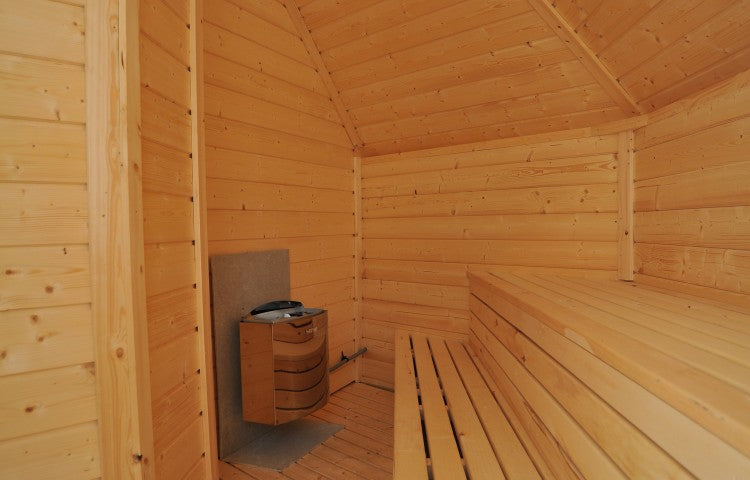Feeling like you’ve been steamrolled after leg day? Infrared Sauna to the rescue! Whether it’s a Home Sauna, Garden Sauna, or an Outdoor Sauna escape, the short answer is: yes, Infrared Sauna helps with muscle recovery. It boosts circulation, reduces soreness, and aids healing. Keep reading to unlock the science and sauna tips.

Understanding Infrared Saunas
What is an Infrared Sauna and How Does it Work?
Unlike traditional saunas, infrared saunas use infrared light to directly heat your body rather than the air around you.
This allows you to sweat and benefit from deep tissue warming at lower temperatures.
An infrared sauna is often found as a Home Sauna or in an Outdoor Sauna setup.
It’s a great way to relax and recover without the intense heat of conventional steam saunas.
Infrared vs. Traditional Saunas
Traditional saunas heat the air, which in turn warms your body.
Infrared saunas skip that step and send light waves straight into your skin, heating you from the inside out.
This means you can get all the muscle benefits at lower temperatures—typically between 40°C and 60°C.
Types of Infrared Wavelengths (Near, Mid, Far)
Infrared saunas come in three types based on wavelength:
-
Near infrared: Penetrates the skin’s surface, helpful for wound healing and skin health.
-
Mid infrared: Targets soft tissue and improves circulation.
-
Far infrared: Reaches deeper into the body, ideal for detoxification and muscle recovery.
Many saunas combine all three to maximise recovery results.
The Science Behind Infrared Saunas and Muscle Recovery
Key Benefits for Post-Exercise Recovery
Infrared therapy is becoming popular in fitness for good reason.
It helps muscles bounce back faster and reduces discomfort after intense workouts.
Here’s how:
Enhancing Neuromuscular Performance and Reducing Soreness
Infrared waves warm the muscles gently, reducing delayed onset muscle soreness (DOMS).
This also helps restore neuromuscular control quicker after hard training.
Improving Muscle Contractility and Stability
Warm muscles work better.
Infrared exposure enhances contraction strength and reduces fatigue.
That means improved muscle coordination and less shakiness post-training.
Reducing Inflammation and Pain Relief
Infrared heat can ease inflammation by improving circulation and supporting cell repair.
It helps reduce muscle aches, stiffness, and joint pain naturally.
Increased Circulation and Blood Flow
Infrared therapy boosts blood flow to tired muscles, speeding up oxygen and nutrient delivery.
This supports faster recovery and tissue repair.
Promoting Detoxification (Sweat and Toxin Release)
Sweating is your body’s way of clearing toxins.
Infrared saunas encourage deep sweating, helping eliminate lactic acid and heavy metals that may delay recovery.
Improved Flexibility and Range of Motion
Heated muscles stretch more easily.
Using an infrared sauna post-workout can support joint mobility and reduce muscle tightness.
Research and Studies Supporting Infrared Sauna for Muscle Recovery
Overview of Key Findings
Studies show that infrared therapy may decrease muscle soreness and improve recovery speed.
Some athletes also report better endurance and reduced muscle fatigue after using infrared saunas regularly.
Limitations and Areas for Future Research
While early results are promising, more large-scale studies are needed.
Most current research uses small sample sizes or combines infrared with other therapies.
This makes it tricky to isolate exact effects.
Practical Guide to Using Infrared Saunas for Muscle Recovery

Recommended Protocols and Best Practices
To maximise infrared sauna muscle recovery benefits, stick to best practices:
Optimal Session Timing (Pre/Post-Workout)
-
Pre-workout: Use for 10 minutes to gently warm up muscles.
-
Post-workout: Best used 20–30 minutes after your session to support relaxation and healing.
Ideal Session Duration and Frequency
-
Start with 15–20 minutes per session.
-
Work up to 30–40 minutes, 3–4 times per week.
Consistency matters more than intensity!
Temperature Settings
-
Begin with 40°C, then work your way up to 55–60°C based on comfort.
-
Always listen to your body and step out if feeling light-headed.
Hydration and Cooling Down
-
Drink water before, during, and after your sauna session.
-
Cool down gradually to stabilise your heart rate and temperature.
Considerations and Potential Risks
When Infrared Sauna Therapy May Not Be Recommended
Infrared sauna use may not be suitable if you have:
-
Heart conditions
-
Low blood pressure
-
Pregnancy
Consult a healthcare provider before beginning any new recovery therapy.
Hydration and Electrolyte Balance
Sweating leads to fluid and mineral loss.
To avoid dehydration:
-
Replenish fluids after your session.
-
Add an electrolyte-rich drink to your post-sauna routine.
Takeaways
-
Infrared Sauna is a game-changer for muscle recovery.
-
It boosts blood flow, reduces pain, and improves performance.
-
Ideal for your Home Sauna, Garden Sauna, or Outdoor Sauna recovery setup.
Just finished a tough workout? Step into the soothing heat and let the healing begin.






